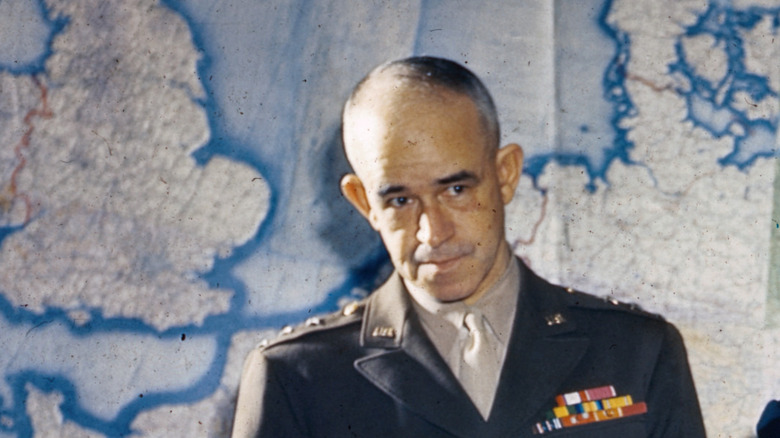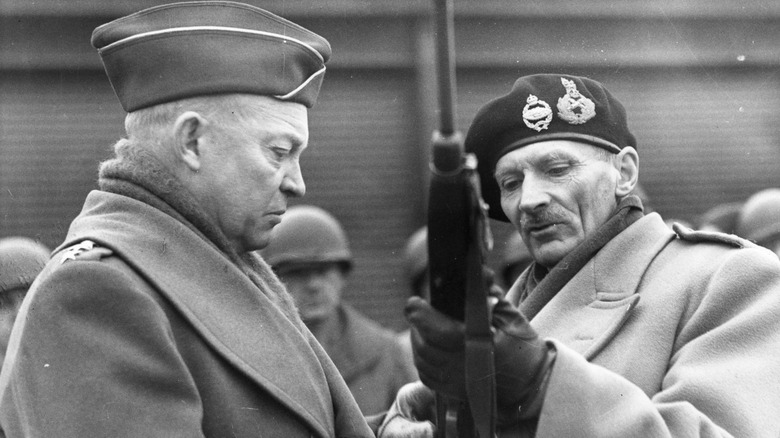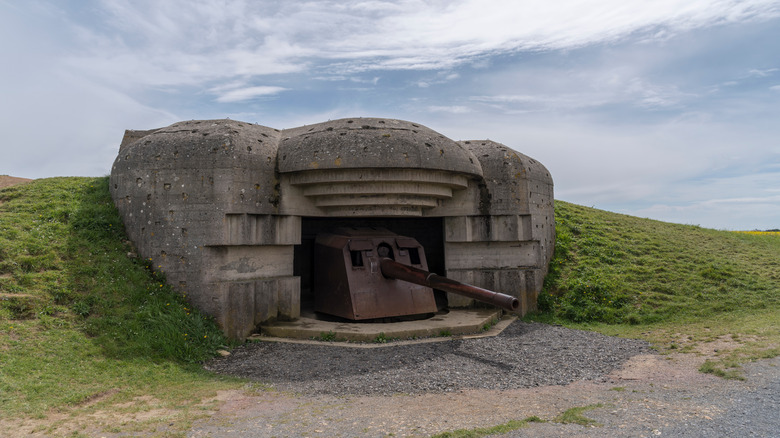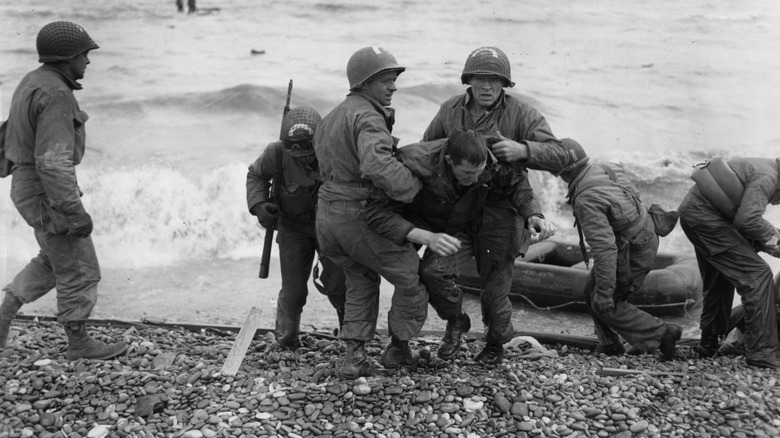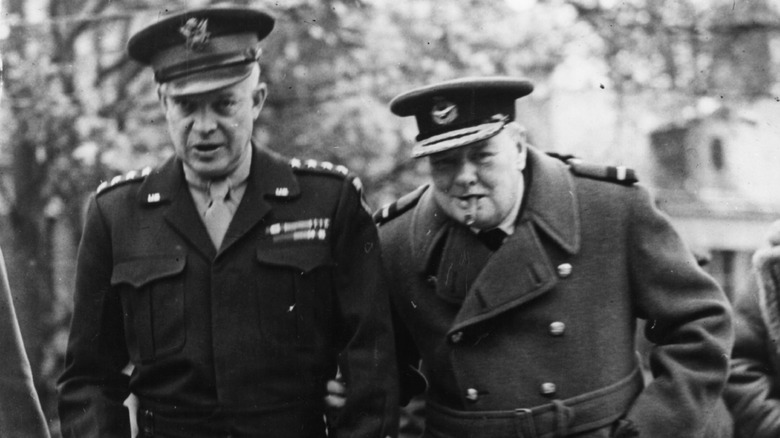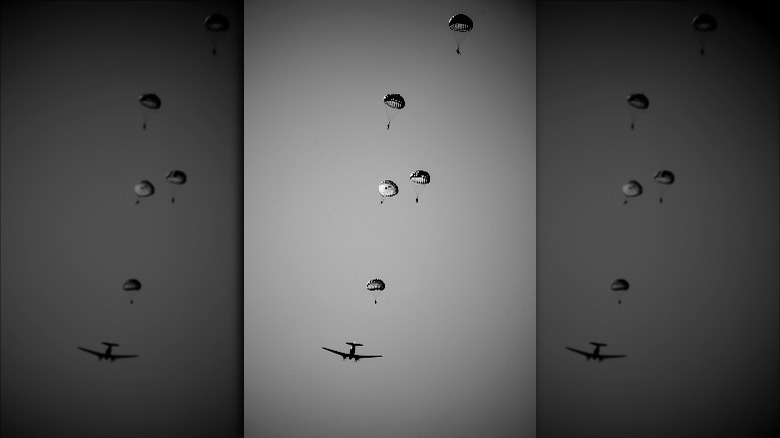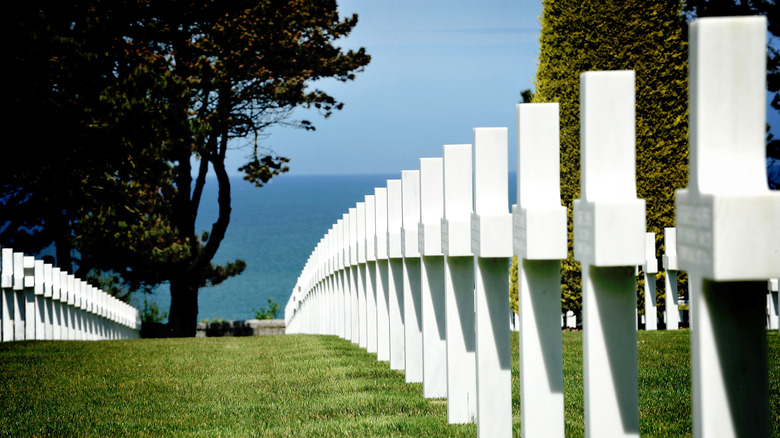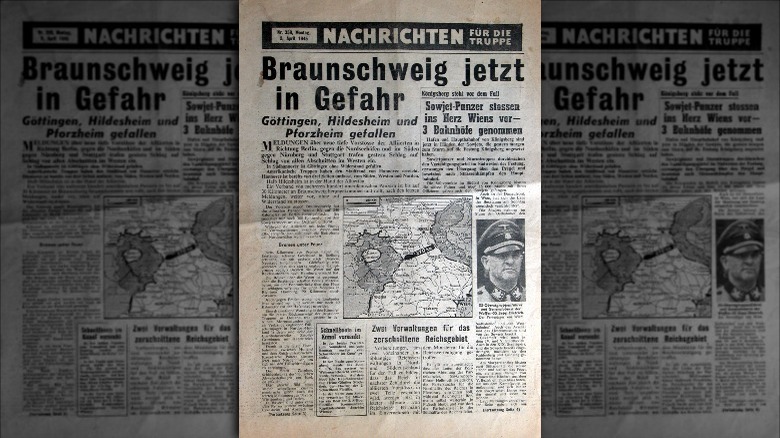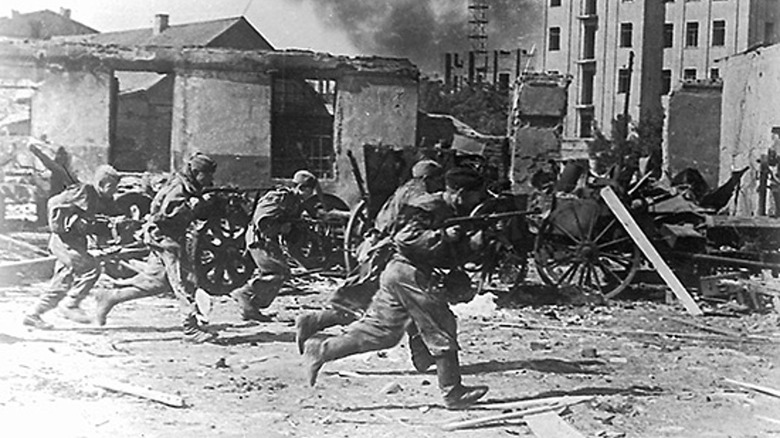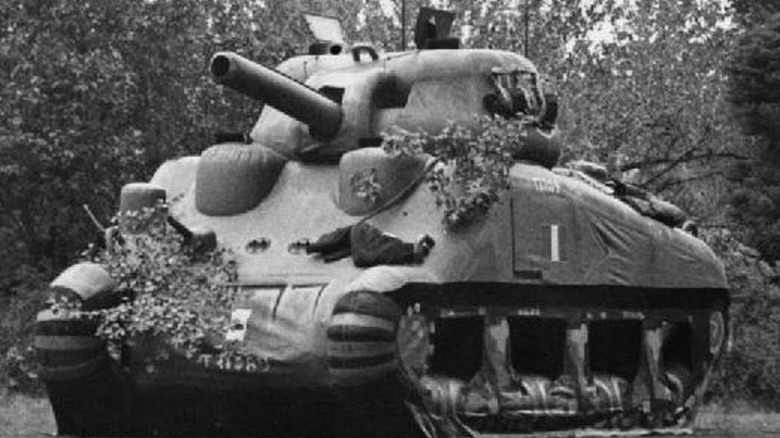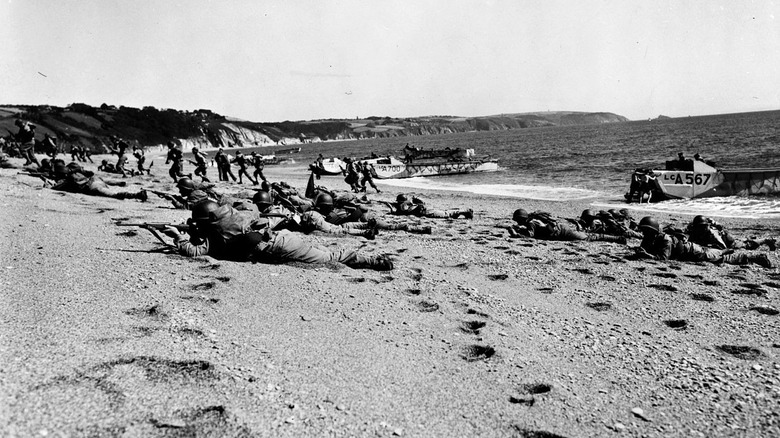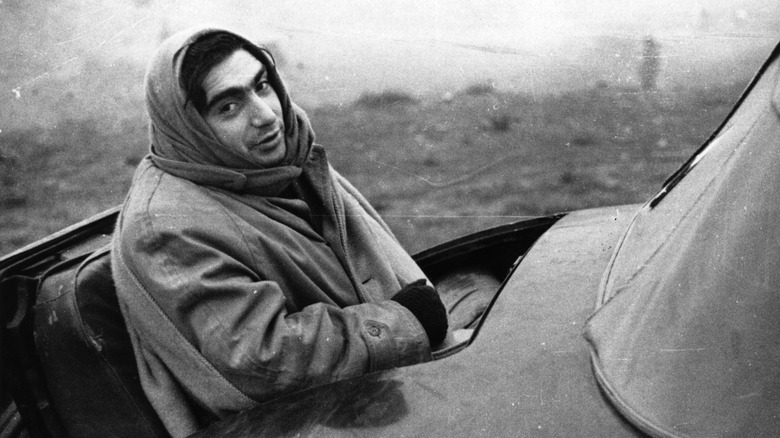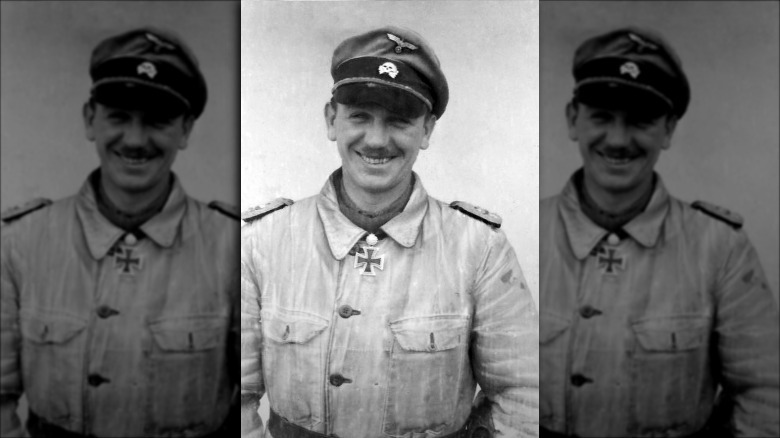The Messed Up Truth About D-Day
June 6, 1944—better known as "D-Day"—was the largest amphibious military operation in history. The Allied forces under the command of American General Dwight D. Eisenhower planned and executed a direct assault on what had come to be known as "Fortress Europe," a heavily fortified area of France across from the British Isles that presented a brutal barrier to any invading force. The invasion began Operation Overlord, and involved nearly 130,000 soldiers, 5,500 landing craft and ships, 20,000 land vehicles, and 13,000 aircraft.
D-Day is remembered as a triumph, as the beginning of the end of Nazi Germany and Adolf Hitler. And it's true that less than a year later the Nazi forces had been broken and the Allies were rolling through Berlin, all remnants of the once-terrifying German military machine destroyed. But D-Day was so complex and so logistically complicated it's simplistic to view it as a massive invasion that kicked Nazi butt. The truth is more complicated, in part because any operation the size and complexity of D-Day is going to get messy, and in part because it's become American Mythology that the U.S. led the biggest invasion ever and ended the worst war of all time. But dig a little deeper, and the mythology doesn't always hold up. Here's the messed-up truth about D-Day.
D-Day came really close to being a disaster
The idea of invading France was first considered as early as 1942. The invasion is often portrayed as a triumph of careful planning and incredibly brave soldiers—and it certainly was both of those things. But that overlooks one key fact: It also came close to being a horrifying disaster for the Allies.
Americans sometimes think that because General Dwight D. Eisenhower was Supreme Commander of the Allied Forces that means America was in charge—but it was a partnership. As History notes, Eisenhower's staff was full of British officers, and the British themselves did much of the planning and logistics work. One of the reasons Eisenhower was chosen for his role was his ability to get combative personalities to work together—but he threatened to quit and throw the whole operation into disarray when the British pushed back on "no-brainer" plans to bomb the German lines prior to the landings.
In fact, as NPR reports Eisenhower was so painfully aware of how easily it could go wrong he wrote out a statement to be issued if it went badly. And things did go wrong—nearly everything, in fact. As Engines of Our Ingenuity notes, the bombs Eisenhower fought for mostly missed their targets, naval bombardments were ineffective, amphibious tanks turned out to be not very amphibious at all, and the weather wasn't ideal, scattering Allied forces. The amazing thing about D-Day is that it succeeded at all.
The Germans made a critical mistake
It was no big secret that the Allies were planning to invade France. As History notes, Hitler and his military advisers began planning for it as far back as 1942. It was the obvious way to force the Nazis to spread their forces thin and ease the pressure on Russia in the East. In fact, Hitler ordered a huge string of fortifications to be built that same year, creating what came to be known as the Atlantic Wall, a network of bunkers, gun emplacements, and landing obstacles that covered 2,400 miles of the French coastline.
So the Germans knew the Allies were coming, and they had the weapons, men, and fortifications in place to repel those forces. The chances of failure would have been pretty high, actually, except the Germans got one crucial aspect of their intelligence wrong: Where the Allies planned to invade.
Through a brilliant deception campaign, the Allies managed to convince Hitler and his high command that the invasion would hit at Calais, about 150 miles northeast of the actual invasion site. The Nazis couldn't be sure, but the possibility forced them to split their forces, a big reason D-Day succeeded. The brilliant part of all this is that Calais is actually the better choice for an invasion, which made it very believable.
Casualties were beyond high
D-Day wasn't just a logistical nightmare, it was a literal nightmare. If you've seen "Saving Private Ryan" you have some small idea of what the first wave of invaders experienced—the D-Day landings were brutal. In fact, they were probably worse than you can imagine.
Estimates of exactly how many men died on those beaches vary pretty significantly, and it's impossible to know precisely how many died in the first wave—but it was a bloodbath. The Guardian notes that thousands of troops were killed by punishing machine gun fire as they waded on shore. The Atlantic recounts how men barely managed to jump out of their landing craft before being "ripped apart" by gunfire. Some entire companies of soldiers were devastated, like A Company, 1st Battalion, 116th Infantry, which lost 60% of its men in 20 minutes. Men in supposedly amphibious tanks drowned, trapped inside, when the tanks hit the water too soon and sank like metal coffins.
The worst part was that this was accounted for. The generals planning the invasion knew incredibly high casualty rates were unavoidable. Author G.H. Bennett notes that it was estimated that 13% of all troops would drown before making it to shore, and the assumption was that 25% of Allied forces would die in a successful operation. And History reports that the Allies expected to lose 75% of the paratroopers dropped behind enemy lines just before the invasion.
Allied Command argued up until the last minute
Considering what was at stake, you might imagine that the military leaders planning Operation Overlord and the Normandy invasion would want to be solidly in agreement before giving the order. The fact is, they argued over just about every detail right up until the end.
HistoryExtra notes that the British and the Americans went back and forth over the details for years. The British even delayed the invasion twice, opting to direct resources to an invasion of Northern Africa (Operation Torch) and later an invasion of Sicily (Operation Husky). There were good military reasons for these decisions, but the Americans suspected the British were trying to undermine the Normandy plan. As UVA Today explains, the British thought invading through Normandy would be too difficult, and weren't afraid to express this opinion. In the end, the British only agreed because they worried the Americans would go their own way otherwise—but Prime Minister Winston Churchill continued to argue over every detail.
History reports this bickering led to incredible chaos right before D-Day. Supreme Allied Commander General Dwight D. Eisenhower actually threatened to resign when Churchill opposed having Allied bombers pulled out of Germany to bombard the defenses in France—which Eisenhower couldn't believe. The threat worked, and the bombers were moved, but it's kind of incredible to think that shortly before the largest amphibious invasion in history the leadership team was in such disarray.
The paratrooper drops were a disaster
The Allied forces knew that any attempt to invade Europe via the Normandy beaches would meet stiff resistance. As Time notes, the German army spent more than three years and incredible resources building a series of impressive defenses called the Atlantic Wall. This series of bunkers and guns emplacements was just the outer edge of German defenses. They'd been in France for years at this point, and there were real concerns that armored divisions and reinforcements from France's interior would lead to an Allied defeat.
As a result, a key part of D-Day involved dropping thousands of paratroopers behind enemy lines shortly before the attack. The 101st and 82nd U.S. Airborne Divisions were dropped on the Cherbourg peninsula and ordered to secure areas, seize bridges and other important transportation links, and sabotage the German defenses.
It was a disaster. According to History, bad weather led to the paratroopers being dropped wildly off-target, leaving them scattered and vulnerable to snipers and easy capture—only one-sixth of the men actually reached their rally points. In the darkness and chaos, many paratroopers were forced to form ad-hoc units on the run. Many drowned when they accidentally landed in flooded ditches or in rivers. The fact that the paratroopers still managed to carry out their mission is nothing short of incredible.
We still don't know how many men died on D-Day
In an age when we have so much data at our fingertips, we generally expect precision. And you might think that nearly 80 years after the D-Day invasion—an operation that was well-documented at every stage—historians would have figured out every detail behind it. But the fog of war is real, and there remain a lot of mysteries surrounding D-Day—including exactly how many men died that day.
Estimates vary wildly. As History notes, when a D-Day memorial was planned in the late 1990s, historians found it very difficult to figure out who actually died on the beach, as opposed to later in the campaign. Initial estimates ranged from 5,000 to 12,000, finally settling on 4,414 casualties. But that number isn't accurate, and continues to change.
As FiveThirtyEight explains, part of the problem is defining the cause of death for a soldier. A wound received on Utah Beach, for example, might take days or weeks to kill the soldier. The clerks who were in charge of tabulating losses also died on those beaches, and the records they carried were lost. And some soldiers simply vanished—either beneath the waves or made unrecognizable by their wounds—preventing them from being counted as an official D-Day casualty. The official number of soldiers who died on D-Day will likely continue to change for the foreseeable future.
Psychological warfare was a huge weapon
When we think of D-Day and the Normandy invasion, we think of guns and bullets, tanks and bombers. We think of the high number of casualties and the immense bravery required to step off those landing craft in the face of withering fire. But there was another aspect to the invasion that was just as crucial—and just as effective: Psychological warfare.
As History Today notes, there was literally a Psychological Warfare Division (PWD) within the Supreme Headquarters of the Allied Expeditionary Force (SHAEF), and the British Political Warfare Executive (PWE) and the United States Office of Strategic Services (OSS, the forerunner of the CIA) collaborated on several psychological warfare operations. As noted by author David Welch, one of their main projects was Nachrichten für die Truppe (News for the Troops), a newspaper designed to look like a legitimate news publication that mixed actual news and other stories with blatant propaganda designed to lower German morale—close to a million copies were dropped in France just before the invasion.
Smithsonian Magazine notes that the British also broadcast a regular radio program hosted by Gustav Siegfried Eins, who presented himself as a dedicated Nazi who was outraged at the behavior and failings of the Nazi hierarchy. As Coffee or Die notes, the psychological warfare was deemed a success because Nazi officers complained about their effect—and because so many German prisoners of war were found with the newspapers and other leaflets in their pockets.
Stopping Germany wasn't the only goal on D-Day
Mainstream history imbues D-Day and Operation Overlord with supreme importance when it comes to ending World War II. The usual narrative is that the Nazis were embedded in Europe, and the only way to end the war was to open up a second front.
But as historian William Hitchcock notes, the Allies had been perfectly happy for years to let Russia absorb Nazi aggression on the Eastern front, though they couldn't say so publicly. And as the History News Network argues, the Germans were more or less doomed to lose the war ever since they failed to capture Moscow in the Winter of 1941, which transformed the war from an aggressive invasion to a slow war of attrition. Put simply, in a grinding war of attrition the math wasn't on Germany's side. The Nazis were already in retreat and doomed. In fact, just a few weeks after D-Day the Russians spearheaded an operation that dwarfed Operation Overlord in every way, Operation Bagration, which involved a staggering 2.3 million men.
So if it wasn't crucial to ending the war, why put so much effort into D-Day? One reason was Allied worries that the Red Army would simply roll over Europe—in fact, this was the stated strategy of the Soviet Politburo in 1944. Operation Overlord was as much about stopping the Russian takeover of Europe as it was the defeat of the Nazis.
The Allies created a fake army and navy
The Allied forces knew the Normandy invasion was far from a sure thing. The Nazis built an impressive defensive line that stretched 2,400 miles of French coastline, and they 100% knew the invasion was coming. If they guessed the location correctly, the chances of failure would be much higher. So the Allies created one of the greatest deception campaigns of all time. Operation Bodyguard involved placing the very real General George Patton in charge of a very fake army called the First U.S. Army Group (FUSAG) in order to convince the Germans that any invasion of Normandy would actually be a feint to draw Hitler's forces away from the real invasion, which would take place at Calais. Patton was chosen precisely because the Nazis knew him very well, and he was a believable choice to lead a major invasion of Europe.
As Sky History TV reports, an entire fake army and navy was created in order to cloud Nazi intelligence and add credence to the Calais ruse. Inflatable tanks and fake boats were constructed, as were fake military installations that looked plausible in grainy spy photos. Entire teams were dedicated to generating convincing radio chatter for the Nazis to pick up.
The ruse worked—Hitler hedged his bets, which softened the resistance at Normandy—and even kept several army divisions near Calais for days after D-Day, still worried the invasion was just a trick.
A rehearsal operation failed hard
Operation Overlord and the Normandy invasions Americans refer to as "D-Day" took years and years of careful planning. So it isn't too surprising to learn that the Allied forces planned a dress-rehearsal to test out equipment and training. What might be a little surprising is how disastrous that rehearsal ended up being.
As BBC News explains, the operation was code-named Exercise Tiger. On April 28, 1944, eight ships designed to convey and land tanks on the beaches of Normandy were sailed with full cargoes to Slapton Sands near Devon, England, where the beach had been fortified similarly to Normandy. The Allies arranged to have live artillery fired near the ships to make the landings as realistic as possible. History reports that 23,000 troops were loaded onto the ships, which headed out to sea, then turned around and returned to stage the practice landing.
But the radio chatter attracted German submarines, which launched an attack on the Allied vessels. A British Destroyer was supposed to have accompanied the ships, but had been ordered elsewhere at the last minute, leaving the tank ships undefended. Three ships were hit by German torpedoes. When the sailors hit the water, they discovered to their horror that they were wearing their life jackets incorrectly, leading many to die of hypothermia in the frigid water. The disaster costs 800 lives, but the families of the army covered it all up to maintain security.
The most famous D-Day photos might be lies
If you've seen the famous black-and-white photos of Omaha Beach on D-Day, you've seen the work of Robert Capa. Known as the "Magnificent Eleven," these are the only surviving photos of about 106 Capa claimed to have shot after accompanying one of the first waves of landings on the beach and remaining there under fire for about 90 minutes, when his camera jammed. The rest of the negatives were destroyed in an accident in the developing lab.
And that's "claimed," because recently Capa's story has come under question. Petapixel explains that a careful investigation implies that Capa landed at an unusually calm area of the beach almost out of range of the guns trained on it, that he stayed on the landing boat for about two minutes before wading in closer, took a grand total of 11 photos, and then raced for another landing craft for the trip back after just 15-30 minutes.
Further, investigators point out that the story about the lab accident that supposedly destroyed the negatives doesn't make sense. Other film shot by Capa showing less dramatic scenes were processed without a problem, and no one with any sort of darkroom experience would have made the decisions supposedly made with the rest. Omaha Beach was a brutal bloodbath and no one would blame Capa for getting out as fast as possible—but the possibility that he lied about his experience there threatens to shade his reputation.
There were war crimes and atrocities on both sides
War is ugly and violent, but over the decades the narrative of D-Day has been established via movies and TV shows to be one of heroism and sacrifice. The soldiers landing on the beach that day are usually depicted as humble men drafted into one of the most important and dangerous invasions, reluctantly practicing violence. The Nazis, naturally, get a less positive spin.
The truth is there were war crimes on both side—massacres, sexual assaults, torture, and worse. HistoryNet reports many incidents where Nazi soldiers outright murdered Canadian prisoners of war, including more than 150 who were killed while trying to surrender. After the war the German officers involved in the incidents were identified, but only one, Kurt Meyer (pictured), was tried for war crimes. He was convicted and sentenced to life in prison, but only served five years.
As The Washington Post notes, the Allies weren't immune from atrocities. After the Normandy landings, many American troops were accused of sexual assault. General Omar Bradley warned the Supreme Commander Dwight D. Eisenhower about "looting, pillaging, wanton destruction, rape, and other crimes" being committed by Americans. But almost none of these crimes were reported or prosecuted.
